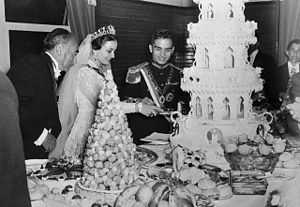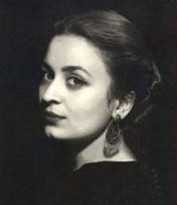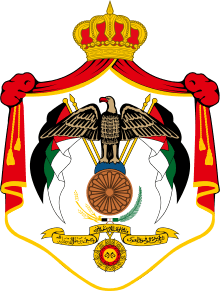Dina bint 'Abdu'l-Hamid
| ||||||||||||||||||||||||
Sharifa Dina bint 'Abdu'l-Hamid (born 15 December 1929) is the former Queen of Jordan (Queen Dina)[1] as the first wife of King Hussein. She is the mother to his oldest child, Princess Alia. She and the king were married from 1955 to 1957, and in 1970 she remarried a high-ranking official in the PLO. She is a graduate of Cambridge University and a former lecturer in English literature at Cairo University. Early life and educationPrincess Dina was born in Cairo, Egypt, to Sharif 'Abdu'l-Hamid bin Muhammad 'Abdu'l-Aziz and Fakhria Brav. A member of the House of Hashemite, she is also entitled to use the honorific title sharifa of Mecca as an agnatic descendant of Hasan ibn Ali and was a third cousin to her father-in-law, King Talal. Dina's lineage, like her future husband, could be traced back to the Prophet Muhammad. Through her mother, Dina was connected to Egypt's Circassian elite. Her father and uncles claimed a waqf that consisted of nearly 2,000 feddans.[2] Like many children of the landed Arab aristocracy, Dina was sent to a boarding school in England, rounding off her education with a degree in English literature from Girton College, Cambridge University, and a post graduate diploma in social science from Bedford College, London.[3] After her return home, she began to teach English literature and philosophy at the University of Cairo while residing in the affluent suburb of Maadi with her parents.[4] As a young woman, Dina was considered highly educated, sophisticated and emancipated, as well as beautiful and well-liked by her entourage and her friends.[5] Queen of Jordan King Hussein and Queen Dina on their wedding day, 18 April 1955 Sharifa Dina first met King Hussein in London, where they were both studying, at the home of a relative from Iraq, in 1952. The King was then at Harrow School while she was at Girton College, Cambridge. The King visited her in Maadi thereafter. She took the Bachelor of Arts degree with honours and was a lecturer in English literature Cairo University prior to her marriage.[2][6] In 1954, two years after her son's accession to the throne, Queen Zein, who exerted a significant influence early in his reign, announced the engagement of the King and Dina. The match was considered to be perfect. Not only was Dina a Hashemite princess, but was brought up with the best education the West had to offer.[7] The union was also strongly favoured by Gamal Abdel Nasser, the future President of Egypt.[8] They were married on 18 April 1955. The bride was 26 and the groom was 19.[2] Upon her marriage she became Queen of Jordan. According to author Isis Fahmy, who interviewed Dina in the presence of her husband on their wedding day, Hussein determinedly said that she would have no political role. Fahmy noted that Hussein had intended to exercise authority over Dina, who was herself a strong personality, and that his mother viewed her as a threat to her own status.[9] It soon became apparent that the king and queen had little in common. On 13 February 1956, she gave birth to the king's first child, Princess Alia, but the arrival of a child did not help the royal marriage.[2] Princess of JordanIn 1956, while the queen was on a holiday in Egypt, King Hussein informed her about his intention to separate from her. Hussein likely did so at the prompting of his mother, Queen Zein, with whom Dina was on bad terms.[7] The couple divorced on 24 June 1957, during a period of strain between Jordan and Egypt,[8] at which time she became known as HRH Princess Dina Abdul-Hamid of Jordan. The ex-queen was not allowed to see her daughter for some time after the divorce.[2] On 7 October 1970, Princess Dina married Lieut-Colonel Asad Sulayman Abd al-Qadir (born 1942 in Bethlehem), alias Salah Ta'amari, a Palestinian guerrilla commando who became a high-ranking official in the Palestine Liberation Organization. He was imprisoned by the Israelis in 1982.[2] A year later, Princess Dina negotiated one of the largest prisoner exchanges in history—freeing her husband and 8,000 other prisoners.[10] International roles and positions
Notable published works
Decorations
References
Bibliography
| ||||||||||||||||||||||||

